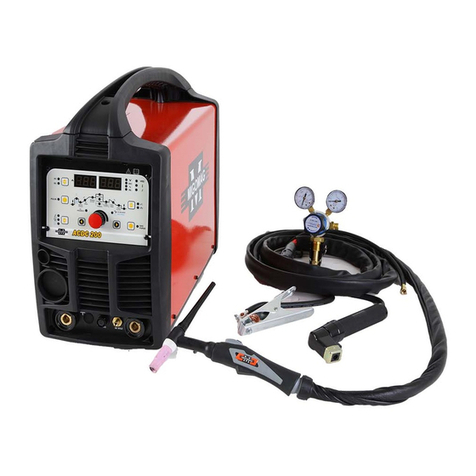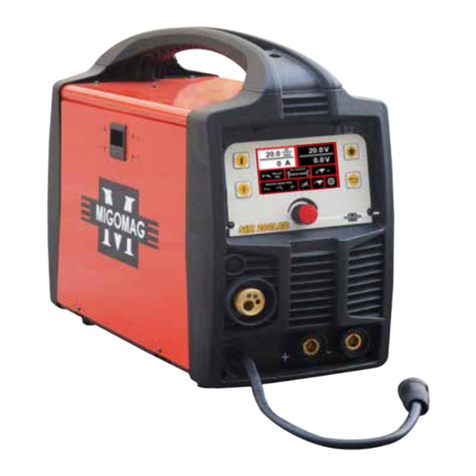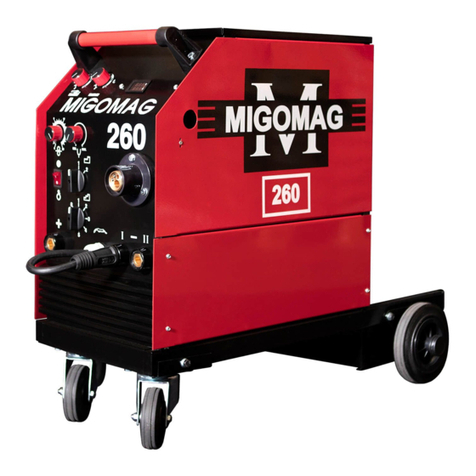5
Progressively select higher voltage positions with increases
in wire speed.
Low wire feed speed settings for a given voltage will
causealargeballtoformontheendoftheweldingwire and
causeexcessivespatter.
High wire feed speed settings for
a given voltage will cause wire stubbing.
Positionthetorch
over the seam to be welded with the nozzleapproximately
70°totheworksurface.
The nozzle to work distance should
be approximately 10mm.
WARN BYSTANDERS TO SHIELD THEIR EYES.
Lower your helmet and press the welding gun trigger
switch to initiate an arc.
As the weld isdeposited,pushthe
torch from a right to left direction,slowlyalongtheseamat
a constant speed. Using the wire feed speed control,
adjust for a 'crisp' soundingarc.
Spot Welding
MIG spot welding is made fromone side of the sheets
placed one upon another so that the high welding current
penetrates through the upper sheet(max.1.5mm) and
also a part ofthe lower sheet.
A circular spot is produced
each time the torch trigger is pressed. The spotweldtime
't1'canbevaried.
Select'spot'weldingbyturningswitch't1"
only.
Fit a spot-welding nozzle to the torch.
See GUN PARTS LIST.
Set voltage and wire feed speed controls to near max.
settings and carry out test welds on scrap materials as
follows:
Position the legs of spot-welding nozzle over weld
position and depress torch trigger switch. At the
termination of the weld, check for weld penetration (small
dimple showing on underside of weld), and adjust spot
weldtimeforbestresults.
When welding sheets of unequal
thickness, the thinner sheet must be on top. Thicker
sheets can be welded together by drillinga hole inthe top
sheet anddirecting thewireinto hole-thisis knownas'plug
welding'.
Spot welding requires ONLY LIGHT PRESSURE;
the sheets are pressed against each other with the legs of
the welding nozzle.
Switch Welding All Models
The wire feed output is switched on and off repeatedly.
This produces a lower heat input which is particularly
advantageous when welding thin or poor-quality materials
aswellasbridginggaps.
Select 'stitch' welding by turning 't1'and 't2'controls to the
halfway setting. Vary time to obtain best results. Theydo
nothave tobeequal.
't1' controls the welding or working cycle.
't2' controls the
pause cycle between welding.
Note: The trigger on the gun must be kept depressed during
bothcycles.
Welding occurs during the working (ON) cycle. During the
pause cycle, the wire feed STOPS, and the arc will
extinguish.
During the pause cycle the moltenpool will cooldown. The
arc will ignite again automatically at the beginning of the
following working cycle when the filler wire makes contact
with the molten pool.
The welding current is automatically switched on and off
and the shielding gas supply will remain on during the
pause cycle.
Note: Spot welding and stitch welding of aluminium is
not possible.
SETTING UP GUN FOR ALUMINIUM WELDING
The Welding Gun
Remove the liner positioner nut from the adaptor block at the
wire feed end of the gun cable. Remove the gas nozzle,
contact tip holder, gas diffuser/ contact tip from the welding
torch and remove existing liner if fitted.
Carefully push the Teflon liner with brass neck liner attached,
through the gun cable until the end of the liner protrudes from
the swan neck.
Adjust the contact tip holder, gas diffuser/ contact tip and gently
push the liner to seat it into the back of the contact tip holder/
contact tip. Replace the gas nozzle.
At the adaptor block end of the gun cable, slide the brass nipple
and “O” ring over the liner until they are located om the recess
in the adaptor block and replace the liner retaining nut.
DO NOT CUT THE TEFLON LINER YET!!
FIGURE 4.
The Welding Machine
With a pair of long-nosed pliers, remove the steel inlet
guide tube from the central adaptor on the front face of the
weldingmachine.
With the Teflon liner still protruding from the adaptor
block
feed the liner through the inlet of the central adaptor until
the adaptor block is butted against the central adaptor.
Fastenintopositionwithadaptorblock locknut.
Cutthelinerintheshape ofa'V',usingasharpknifeso that
it butts up to the feed rollers as pictured. (FIG.4.) Remove
the welding gun from the machine and cut the brass
support tube so that it is 3mm shorter than the protruding
Teflonliner.
Slide the brass support tube over the liner and enter the
Teflonlinerwithbrasssupporttubefittedintotheinletin the
central adaptor. Feed through until the adaptor block is
buttedagainstthecentraladaptorandtightenthelock nut.
Replace the wire hub tension by backing off the nutin the
centre ofthehubuntilthenutispositioned attheendof the
stud.
After confirming the wire feed roll is the correct size for the
aluminium wire being used, and that the wire is fed through
the gun cable, back off the wire feed roll pressure screw until
the feed roll no longer feeds the wire and re-tighten
approximately 2turns. Toomuchpressure willdeform the soft
aluminium wire and cause the wire to jambin thecontacttip.
Note: To help prevent wire deformation
‘U' groove
feed roller is a better alternative than a 'V'
groovefeedroller.
Contact Tip
Aluminium welding requires a contact tip with greater
clearance than that used for steel. Special clearance contact
tips are available for welding aluminium and are designed
withAsuffix.e.g.0.9A,1.2A.
PARTS LIST
Part No. Description
1260005 Teflon Liner 1.0mm
1260021 Teflon Liner 1.2mm
1290461 Brass Support Tube for Teflon Liner
1310001 Nipple for Teflon Liner
86003033 Drive Roll 0.9/1.0-1.2mm AI (195 230 260
300)
86003066 Drive Roll 0.9/1.0-1.2mm AI (350 400)
1410004 Contact Tip 0.9mm Aluminium
1410006 Contact Tip 1.0mm Aluminium
1410010 Contact Tip 1.2mm Aluminium
86007001 Brass Neck Liner
































